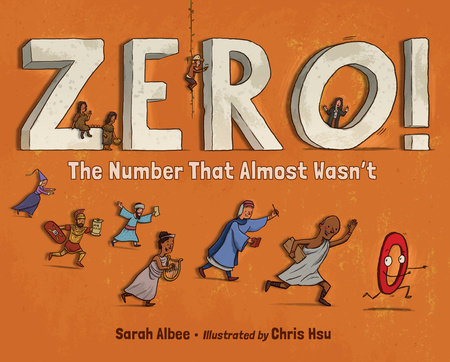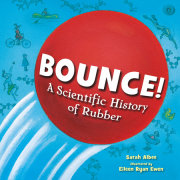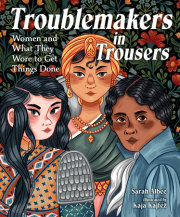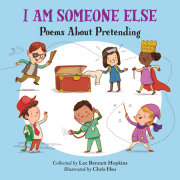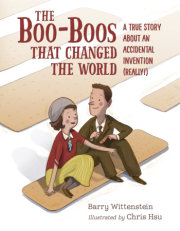♦ Albee constructs a conversational, matter-of-fact narrative about the many years humans calculated on counting boards, used their fingers, put knots in strings and beads on lines, all for the lack of a—nothing. Until the Babylonians around 300 BCE, there was no such thing as a placeholder for single digits, tens, hundreds, and beyond. It’s another 500–700 years before an mathematician in ancient India uses zero not only as a placeholder, but a number. Then comes adoption—not everyone is a fan of zero, including the Christians fighting a holy war against Muslims, suspicious of zero’s Indian/Arabic associations. A brilliant unfolding and pacing of the narrative bring order to the near-misses and chaos of zero’s origins, shored up by the various obstacles readers can discover in the time line. That calculus and algebra were also invented along the way feels nothing short of miraculous. Hsu’s global scenes are cheerful and accessible, with pages that show people counting, adding, sorting, much as children do. It all adds up to an epic story of the little nothing that could, and did, launch or change engineering, modern physics, computing, and electronics forever. VERDICT Educators can build an entire lesson around zero, especially given the thoughtful resources and chatty time line provided in the back matter.
—School Library Journal, starred review
♦ This cheerful picture book tells the story of how it took thousands of years for humans to realize that something was missing: a zero! It explains why it was so difficult to imagine something that actually meant nothing and documents how this emerging concept of nothingness fared in various civilizations around the world, taking several centuries to finally catch on. From the ancient Babylonians, the first to assign place values and realize that they needed a symbol showing nothing in this position, to Brahmagupta, a mathematician from India who wrote in Sanskrit to explain the significance of the numbers zero through nine, the plot follows the development of increasingly more complex math applications, from algebra (Persia) to calculating (Fibonacci) to calculus (Isaac Newton and Gottfried Wilhelm Leibniz). The book mentions initial European resistance, including how a few Christian leaders actually banished zero, until the invention of the printing press helped spread the concept and led to innovations in physics, engineering, electronics, and computers. Appealing digital drawings and rich back matter (uses of zero in everyday language, definitions, a time line, references, a bibliography, and a key to historical clues found in the illustrations) help round out this unique and attractive STEM offering.
—Booklist, starred review
♦ This fun and fascinating story traces the lengthy path from “nothing” to a functioning zero.
Albee begins with prehistory (since the concept of nothing long predated the idea of zero) and progresses to the Babylonians, ca. 300 BCE, while also noting the Mayans’ independent invention of zero. She then credits the “unknown Indian mathematician” who first wrote zero as a numerical symbol (identified in the timeline as the Bakhshali manuscript), followed by Brahmagupta, who used zero in calculations. Many pages are devoted to the challenges of getting zero to be accepted in Europe, where it eventually enabled calculus and the scientific revolution. The backmatter notes that zero was crucial to computer coding. The book brilliantly traverses the history of zero across time and continents and clearly explains its initial value as a placeholder. Elegant and delightfully intricate illustrations superbly evoke history in clothes and settings. The composition of the spread depicting mathematician Fibonacci is, per the backmatter, “roughly organized [per] the Fibonacci sequence”—an especially clever detail. Numerous figures are brown-skinned; many are female. The art alone will grab many readers, who will readily stay to be enthralled by the numbers.
An excellent historical and mathematical introduction to a key concept. (more information on zero, map, bibliography, further reading, timeline, notes about the art)
—Kirkus Reviews, starred review
Everyone understands what it means to have nothing, but readers may be surprised to discover that zero as a mathematical concept is fairly recent. Albee charts the development of this revolutionary concept from the Babylonian introduction of placeholders to zero’s influence on calculus and modern fields of knowledge from physics to computer science. An important aspect of the narrative is the fundamental contributions of nonwestern cultures such as the Mayan and Arabic cultures. Abee also shares roadblocks to the zero’s acceptance, such as European Christian leaders who banished it, arguing that something that represented nothing must be “the work of the devil.” Hsu’s playful illustrations feature a cartoon personification of zero who not only observes its development, but sometimes takes an active role, such as standing next to the great Persian mathematician Al-Khwarizimi as he introduces the concept to fellow Persians. Back matter includes information about other words for zero, number systems, and the terminology; a brief bibliography; detailed timeline; and some fun notes on the illustrations. This is an excellent addition to books on math history and concepts.
—Children's Literature





